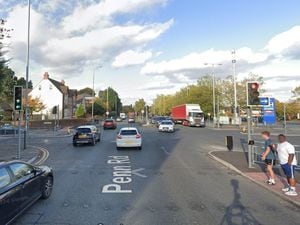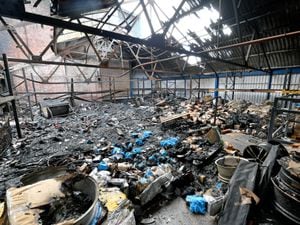Launch of a golden vision at Molineux
A stadium to rival the best in the English game and a team to match - Steve Morgan today committed £16 million to kick-off his ambition to return Wolves to the top tier of the Premier League.
A stadium to rival the best in the English game and a team to match - Steve Morgan today committed £16 million to kick-off his ambition to return Wolves to the top tier of the Premier League.
His decision to launch phase one of his three-tier plan comes despite Wolves occupying the relegation zone of the Premier League, and work on the Stan Cullis stand will start in less than four months. His message — this is a long-term vision which needs a bold backer behind it.
Fans can today dare to dream of sell-out crowds of 37,000 watching a resurgent side slug it out with the giants of Manchester United, Chelsea and Liverpool. If Mr Morgan has his way this season's triumphs against those three teams will become more common.
And leading figures in the city hope success for Wolves will bring investment flooding in. Council leader Councillor Roger Lawrence today hailed the Molineux masterplan as a "vote of confidence in Wolverhampton" and a "beacon for the regeneration of the city".
Councillor Lawrence seized on today's announcement as a timely boost.
The scheme will create an extra 350 jobs in and around the stadium on matchday while 100 construction workers from the West Midlands are expected to be involved in erecting an iconic, modern landmark dominating the skyline.
Wolves owner Steve Morgan hopes his bold vision can be the spark for the resurgence of a city reeling from recent setbacks including the collapse of the £300million Summer Row shopping complex. Plans for a £15m Hilton hotel on Penn Road island have also stalled.
Instead hopes rest on his £40m stadium project creating a striking 37,000 seater venue, with scope for increasing capacity to 50,000, of which today's £16m commitment represents just the first phase.
Mr Morgan told a press conference today that the time was right to launch the redevelopment.
He said: "Because of the economic climate tender prices have not been better for many many years.
"I have always been counter-intuitive anyway, I have always felt it's best to do something when no other bugger is doing it.
"I think it's a good time. Some might say it's never a good time but it's as good a time as any. You can't make decisions like this based on the Bolton result when we lost to a 93rd minute goal, or beating Manchester United, the first time they have been beaten all season.
"You have to base it on where you are going. Where we are going at this club is onwards and upwards."
He added: "As well as football, we have always stressed the importance of the club also paying a key role in the life of the city.
"We are keen for Molineux to grow as a source of immense civic pride for everyone in Wolverhampton. The redevelopment of Molineux will provide a much-needed economic shot in the arm for the city."
Councillor Lawrence said the go-ahead for phase one of the project, the rebuild of the Stan Cullis stand, was "tremendous news". T
he council leader, a season ticket holder at Molinuex, said: "The football club is part of the lifeblood of this city and I know I will speak for many people when I congratulate Steve Morgan and the Wolves board of directors for their vote of confidence in Wolverhampton with today's announcement.
"A redeveloped Molineux will not only be a superb venue for what we all hope will be continued Premier League football, but also a beacon for the ambitions we have to regenerate the city. The council has been delighted to support Wolves in putting its plans together for the stadium redevelopment."
Joy
Business leaders also spoke of their joy at Mr Morgan's decision to press ahead.
Henry Carver, managing director of Carvers Building Supplies, recently revealed he hoped to form a trailblazing group to campaign for measures to revitalise Wolverhampton.
He said today: "Wolves is an integral part of the success and pride of this city and hopefully this huge investment will encourage others. Well done Wolves."
Speculation Mr Morgan would decide to delay the development has been rife in recent weeks as the team's stuttering form on the pitch has left them scrapping for survival.
However chief executive Jez Moxey revealed retaining Premier League status was never a 'must' for the project to go ahead.
"Our league position has been a consideration all season long, but clearly we are pressing the button before we know we are safe," he said. "We have belief in the team and its ability to stay up this year but this decision, obviously, is not dependant on that."
The first three phases of the development, taking capacity to 37,000, could be completed in time for the 2014/15 season. A decision on whether to boost it to 50,000 will be taken at a later date.
Even the 37,000 seater venue is expected to draw 800,000 people a year to Molineux and Wolverhampton on a matchday, or to visit the club's new museum, store or conference and banqueting suites.
But the grand plans have come with a warning of disruption and reduced capacity while the work is carried out. And today the club revealed how fans will be moved when phase one gets under way in May.
During redevelopment the capacity of the stadium will drop to from around 29,000 to 23,995. Fans in the Stan Cullis stand, being demolished during this phase, and in the Jack Harris stand, will be relocated next season.
Away fans will be placed in the Jack Harris flank while the Stan Cullis is being redeveloped. It means new seats will have to be found elsewhere in the ground for fans who normally sit in the Jack Harris stand, as well as more than 5,000 supporters from the Stan Cullis.
Club bosses say fans will pay no extra for the new seats, issued for the 2011/12 season, even if prices are usually higher there.
Supporters renewing their season tickets under Wolves' early bird discount scheme are advised to complete the application for their existing seat. Details of their relocation will be sent out in due course.
Once the redevelopment is complete displaced fans will be moved back to their original stand.
The club's head of ticketing and memberships Lynne O'Reardon said: "We have spent many months talking to fans and planning the fairest way possible to manage the difficult transition period.
"We've said many times that disruption is inevitable for some supporters and we ask our fans for patience whilst we work hard to deliver a facility which we can all be proud of.
"Communication will be crucial throughout this whole process. We will be writing directly to each affected supporter. We will also be carrying out more fan consultation events during the week ahead." And Wolves say in the long-term the club's plans will improve the matchday experience for fans.
The new Stan Cullis stand will extend into the north east open corner. Once it is complete away fans will be placed in the new corner.
It will bring an end to disruption for fans in the Jack Harris flank who currently have to move into the Steve Bull stand for some matches, when away supporters take their seats.
The two-tier Stan Cullis will incorporate a new club megastore, museum, café, family information centre, pitch-facing hospitality facilities and large video screen mounted on the underside of the roof.
The club could then choose to go ahead with phase two at the start of the 2012/13 season — although the club's hierarchy is keen to stress the project could be paused following any single phase. The Steve Bull stand would be demolished and replaced to adjoin the Stan Cullis stand. The new Steve Bull would feature 42 executive boxes and include a 550 capacity banqueting hall. Phase three would add a tier to the Jack Harris stand and connect it to the Steve Bull.
Fans have been promised double the amount of space in concourse areas as well as all the new facilities.
TV star and Wolves fan Suzi Perry said today: "It's a vote of confidence for the club and Wolverhampton. It's fantastic that we have an owner that is prepared to invest in the club in the long-term. To start phase one now in the situation we are in is an added bonus.
"This will be a Premier League stadium, and with that the play needs to match it.
"We are giant slayers when we play the way we can and we proved that on Saturday.
"My dad has been going to Wolves all his life and he said the atmosphere was electric.
"We are in a false position and hopefully we can slip up the table and take back our rightful position in the Premier League.
"We have a young squad quite cabable of being a very good team and with this we will have a stadium to match. I think this is a massive commitment by Steve Morgan and it shows he's got faith in the club.
"If this first phase could just aid us stopping up in the Premier League then we can build on that next season. Not just for the club, but for Wolverhampton, it's a great decision. It is a positive and optimistic project."
Today's announcement is the latest chapter in the rich history of Molineux.
Wolverhampton Wanderers have played at the site since 1889. Their previous home was in the Blakenhall area, and although no signs of the ground remain, a nearby road is called Wanderers Avenue.
The Molineux name originates from Benjamin Molineux, a local merchant who built his home on the grounds. Northampton Brewery, who later owned the site, rented its use to Wolverhampton Wanderers in 1889, who had previously lacked a permanent home.
After renovating the site, the first ever league game was staged on September 7, 1889, in a 2—0 victory over Notts County before a crowd of 4,000.
In 1953, the stadium became one of the first to instal floodlights, at an estimated cost of £10,000. The first ever floodlit game was held on 30 September 1953, as Wolves won 3—1 against South Africa.
The old South Bank at Molineux is also historically the second largest of all Kop ends closely followed by Aston Villa's Holte End, both of which regularly held crowds in excess of 30,000.
When Wolves were at their height of success during the 1950s Molineux regularly held over 50,000 mostly standing spectators. By the time of their sharp decline during the 1980s, only the newly built 9,500-seat John Ireland Stand, now the Steve Bull Stand, and the much reduced South Bank (15,500) were in use.
This reduction in capacity was due to the fact that the other two stands were wood-built and declared unsafe following the Bradford City stadium fire, in which a wood-built stand caught fire and killed 56 people in 1985.
In the days before the Taylor Report, which required British football stadia to provide seating for all those attending, the ground had a capacity of over 60,000. The record attendance for a match at the ground is 61,315 for a game against Liverpool in the First Division on February 11, 1939.
Between 1991 and 1993, Molineux was comprehensively redeveloped. The Waterloo Road stand was replaced by the all-seat Billy Wright Stand, the North Bank terrace was replaced by the Stan Cullis Stand, and the South Bank terrace was replaced by the Jack Harris Stand.
By the 1993—94 season the Molineux had a 28,525 all-seated capacity making Molineux the 26th largest in English football. But by the time of the 2003 promotion, Molineux was the 15th largest Premiership stadium.
As a result of Wolves' promotion to the Premier League in 2009, Wolves reinstated the temporary seating stand in the southwest corner of the stadium, raising the current capacity to 29,195.
This had previously been employed between 2003—2006, after their previous promotion to the top flight, then known as the Graham Hughes Stand.





